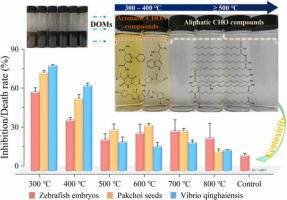Journal of Hazardous Materials ( IF 12.2 ) Pub Date : 2021-09-26 , DOI: 10.1016/j.jhazmat.2021.127346 Zhengliang Du 1 , Aibin Hu 1 , Qiandi Wang 2 , Jing Ai 1 , Weijun Zhang 1 , Yong Liang 3 , Mengxi Cao 3 , Hanjun Wu 4 , Dongsheng Wang 2

|
Sludge pyrolysis carbonization has shown potential to convert sludge biomass into multifunctional carbon materials. However, ecological risks of dissolved organic matters (DOMs) with obscure molecular characteristics retaining in sludge-based carbons (SBCs) have received little attention. This study investigated the impact of pyrolysis temperatures on the molecular conversion and biotoxicity effects of DOMs in SBCs. The results revealed that DOMs in SBCs300–400 were mainly derived from depolymerization of biopolymers and the polycondensation and cyclization of small intermediate molecules, which mainly consisted of aromatic CHON compounds with 1–3 N atoms, featuring high unsaturation and molecular weights. High-temperature pyrolysis (500–800 °C) promoted the decomposition and ring-opening of aromatic CHON compounds into saturated aliphatic CHO compounds with 2–4 O atoms in SBCs500–800. Noteworthily, SBCs300–400-derived DOMs showed relatively strong biotoxicity on the growth and development of wild-type zebrafish embryos, pakchoi seeds, and Vibrio qinghaiensis Q67, which was significantly related to aromatic amines, phenols, and heterocyclic-N compounds in DOMs of SBCs300–400. SBCs500–800-derived DOMs were mainly straight-chain fatty acids and showed no observable acute biotoxicity. This study highlights the negative impact of DOMs in SBCs on the ecological environment, and provides the theoretical basis for controlling toxic byproducts in sludge pyrolysis process.
中文翻译:

污泥基碳中溶解有机物的分子组成和生物毒性效应:热解温度的影响
污泥热解碳化已显示出将污泥生物质转化为多功能碳材料的潜力。然而,具有模糊分子特征的溶解有机物(DOMs)保留在污泥基碳(SBCs)中的生态风险却很少受到关注。本研究调查了热解温度对 DOM 在 SBC 中的分子转化和生物毒性效应的影响。结果表明,SBC 中的 DOM 为300-400主要来源于生物聚合物的解聚和中间小分子的缩聚和环化,主要由具有1-3个N原子的芳族CHON化合物组成,具有高不饱和度和分子量。高温热解(500-800 °C)促进芳族 CHON 化合物在 SBC 500-800中分解和开环成具有 2-4 个 O 原子的饱和脂肪族 CHO 化合物。值得注意的是,SBCs 300-400衍生的DOMs对野生型斑马鱼胚胎、小白菜种子和青海弧菌Q67的生长发育表现出较强的生物毒性,这与DOMs中的芳香胺、酚类和杂环-N化合物显着相关。 SBC 的300–400。SBC 500–800衍生的 DOM 主要是直链脂肪酸,没有表现出明显的急性生物毒性。本研究突出了SBCs中DOMs对生态环境的负面影响,为污泥热解过程中有毒副产物的控制提供了理论依据。









































 京公网安备 11010802027423号
京公网安备 11010802027423号